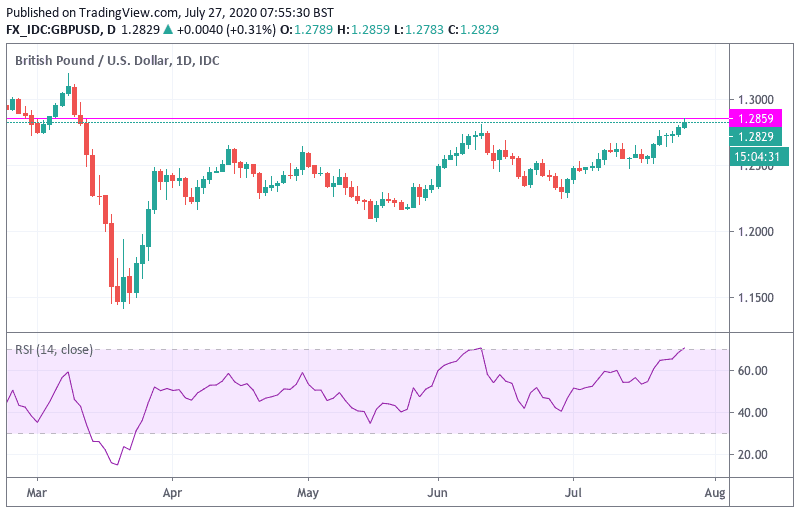British Pound Strikes Four-Month High against Dollar
- GBP/USD rallies on further USD weakness
- USD sell-off starting to look overdone, beware recovery
- GBP/EUR seen edging lower amidst ongoing Brexit uncertainty

Image © Adobe Images
The British Pound has rallied to reach a four-and-a-half-month high against the U.S. Dollar on Monday after the GBP/USD exchange rate hit 1.2859 amidst an ongoing rout of the U.S. Dollar.
The U.S. Dollar has come under significant pressure over the course of the past week and the rally in GBP/USD is therefore not necessarily a vote of confidence in Sterling, indeed the UK currency is expected to underperform many of its European peers over coming days with one analyst saying there is little reason to be optimistic on Sterling due to stalled EU-UK trade negotiations.
"It should be more of the same for GBP (this) week, with the currency remaining the laggard and the underperformer in the European G10 FX space. No progress on the UK-EU trade negotiations is expected and with news headlines suggesting an increased perceived probability of the no deal, there is a little to be optimistic about GBP," says Francesco Pesole, FX Strategist at ING Bank N.V.
"GBP/USD continues to grind higher. But this is merely a result of dollar downside. GBP down against most G10 currencies on a Month to Date basis. UK-specific factor remains negative," says Vasileios Gkionakis, Global Head of FX Strategy at Lombard Odier & Co Ltd. While GBP/USD is rising, there remains a sense it would be flying significantly higher were the GBP part of the equation providing additional lift.
Sentiment to Sterling remains subdued primarily on the basis that the EU and UK remain unable to reach a post-Brexit trade deal, something that must be reached by year-end if the two economic areas are to avoid defaulting to trading on WTO terms.
The latest round of talks ended last week with further confirmation that significant divergences remain, particularly over future fishing rights in UK waters and rules on state aid.
Until some kind of agreement is reached on the outstanding points expect the market to remain cautious of Sterling and for this reason any major recovery in GBP/EUR appears to be a remote possibility. ING say the Pound-to-Euro exchange rate (GBP/EUR) should ultimately remain on track to breach the 1.0870 level over the course of this summer given Sterling's status as a laggard and the Euro's newfound energy.
Indeed, the Euro is the key beneficiary of the Dollar's weakness with the EUR/USD exchange rate ramping up again to quote at 1.1714 on Monday, its highest since September 2018. This is in turn adding upside pressure to the Euro-Pound exchange rate which is up a quarter of a percent at 0.9126 (GBP/EUR down to 1.0957),
The weakness of the Dollar is the leading story in global FX at present, with traders and investors asking whether the sell-off in the Greenback will pause this week as it is now looking oversold on short-term charts. The Relative Strength Index (RSI) - a measure of momentum - is now at 70.5 on the GBP/USD exchange rate which makes it officially overbought and due a pause. (An RSI at 70 = overbought, RSI at 30 = oversold).
Above: GBP/USD at highest since March, but RSI in lower panel says rally is starting to look overdone.
Secure a retail exchange rate that is between 3-5% stronger than offered by leading banks, learn more.
The RSI on the EUR/USD is meanwhile at 19.80 which makes it significantly overbought and due a correction. ING expect the U.S. Dollar's decline to ease this week which should mean the rally in the EUR/USD and GBP/USD exchange rates should pause for breath this week.
Of course looking at the RSI is just one angle to take when approaching these key exchange rates, and we must consider that the fundamentals appear to be shifting away from the Dollar as it appears markets are shunning the Greenback amidst expectations the Federal Reserve will likely stay 'dovish' for longer than anticipated in order to support the economy.
This will only continue to weigh on the yield paid by U.S. government and corporate bonds, thereby prompting investors to look elsewhere for returns.
"The market has taken a view on the dollar, and it does not look pretty for the greenback. It seems that every shift in newsflow is being interpreted as dollar weakening right now," says Richard Perry at Hantec Markets. "However, it is the perception of the US economic recovery lagging in the second half of the year which seems to be the major factor in driving the dollar lower."
Furthermore, the U.S. is struggling to contain the covid-19 outbreak which should blunt the economy's recovery over the course of the second half of 2020, just as the EU and UK are picking up some speed.
"The key phrase is 'rotational flow'; we see EUR/USD trading at 1.19 and 1.21 in 3M and 6M respectively with a weaker USD being a key driver of those calls. Flatter COVID-19 infection curves in Europe vs the US will feed that rotation until the economic data says otherwise," says Stephen Gallo, European Head of FX Strategy at BMO Capital Markets.
Another concern for the Dollar is the November election which should inject a dose of political uncertainty into the U.S. Dollar over coming weeks. "Speculation that US/China relations will improve if Biden wins the Presidential election in November and speculation that a Democratic Presidential will increase regulation and taxation resulting in a less market friendly environment are also part of the worsened outlook for the USD," says Jane Foley, Senior FX Strategist at Rabobank.





